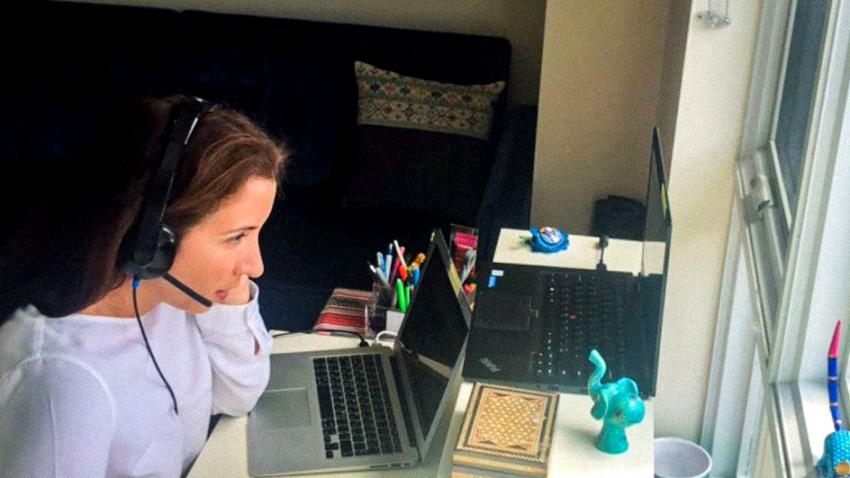
After a string
of theoretical posts, here’s one on a practical and very contemporary topic.
Distance interpreting aka remote interpreting means that the interpreter is not physically present in the place where the speaker(s) and listener(s) are located but is connected to them by audio or visual link from a separate site. The opposite is on-site interpreting. It’s by no means new. In my All of Interpreting, written 30 years ago (see Sources below), there was already a section about it. The American telephone interpreting enterprise LanguageLine had been launched in 1982 and been acquired by AT&T. It remains very successful both in the service it provides and commercially, as do the many similar enterprises that you can see advertised nowadays on the internet. They are widely used by hospitals, social services and the police. Whatever their shortcomings compared to on-site interpreting, they can offer immediate 24-hour availability and a wide variety of lesser-spoken languages; and above all they are economical.
Modern
technology has extended these services to video interpreting and hence to sign
languages.
However, a
characteristic of all such services has been that they were intended for person-to-person
communication or for small groups that could be connected in a conference call;
what is often referred to as dialogue interpreting. Now the advent of computer
platforms like Zoom and Skype makes it possible to interconnect much larger
groups and to have remote conference interpreting. Zoom, for example, provides
a simple interface and claims to allow access to online meetings with up to 500
attendees.
Then came the
bombshell, Covid-19. It decimated the conference interpretation market by
cancellation of many meetings. And it threw a spanner into the logistics because
interpreters could no longer move around freely. It even reached to the holy of
holy of conference interpretation, the United Nations headquarters in New York.
“When the coronavirus pandemic brought New York City to a halt, United Nations interpreters ran into big trouble: their booths and equipment were no longer accessible. However, they are rising to the challenge, exploring new ways to service multilateral meetings, including from their homes...
“’We unexpectedly found ourselves in our apartments wondering how to continue performing our duties and contribute to multilingualism,’ said Veronique Vandegans, Chief of the French Interpretation Section. ‘However, it quickly became apparent that we could adapt and interpret remotely, given the proper equipment, testing and training.’"
So much for the many objections. Suddenly it could be
done, as surely as when Léon Dostert introduced simultaneous interpreting over
the objections of the old guard of consecutive interpreters in the late 1940s.
No one doubts that there are problems. For instance,
“One major challenge is [for interpreters] to find a suitable place in their homes. Even under optimal conditions, a home location is not on par with a confined booth, where interpreters can reach the high level of concentration their job requires.”
Some improvements could be made. The quality of the
equipment is crucial. Early experiments in the 1960s failed because
communications were uneven or the sound and picture were too poor. One of my own
early experiences with remote interpreting was for a televised Canadian election
debate in 1984. On that nationally important occasion it was decided that the
interpreters couldn’t be accommodated in the studio with the candidates, and so
the TV engineers provided me with a video link to a room in another part of
Ottawa. In so doing, they provided me with something I never had again: a giant
TV screen that made me feel I was really present in the debate studio; and when
they did close-ups of speakers I could see their expressions better than I
would have on site. I would still recommend larger video screens. On the other
hand, something they didn’t provide was a circuit for direct connection and
feedback between the interpreter and the moderator of the debate. On site, if there
is any hitch the interpreter can wave to the meeting participants or send a
colleague to explain.
Also a long time ago there was a proposal, I think in
Eastern Europe, for a centre where there would be a pool of remote conference interpreters
on permanent duty instead of arrangements being set up anew for each event. I don't know what became of it.
But now the question is, what will happen when the
crisis eventually subsides? Return to
the old way or consolidate the new? I think the latter, inevitably, because of
the economies it represents. Only very rich users like the United Nations or the
Canadian Parliament will be able to hold out against it. Of course something is
lost in remote interpreting, but every new technology requires a trade-off
between craftsmanship and price.
In addition, the
success of both remote dialogue interpreting and remote conference interpreting
make it imperative to add them to the training for student interpreters in the
universities.
Sources
United Nations
Department of Global Communications. Portraits: UN interpreters adapt to new work
modes during Covid-19. August 2020. https://www.un.org/en/coronavirus/portraits-un-interpreters-adapt-new-work-modes-during-covid-19
or click [HERE].
Brian Harris. All of interpreting: a taxonomic
survey. https://www.academia.edu/12072834/All_of_interpreting_a_taxonomic_survey
or click [HERE]. A Spanish translation is available from the same site under the title Panorámica de los distintos tipos de interpretación.
LanguageLine Solutions. Wikipedia, 2020.
Canadian leaders debates. Wikipedia, 2020.
Image
Lana Ayyad, Chief of
Arabic Interpretation Section, works from her apartment in Brooklyn. UN
Photo/Manuel Elías UN Photo/Manuel Elías.
